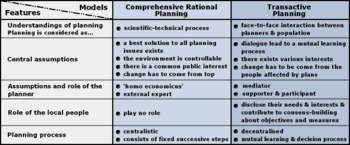Planning approaches
Planning models describe how planning may proceed. Several models have been developed over the past decades. Each reflects different values and assumptions about the nature of the world for which planning is done and about the role of the planner [1]. Two important ones for natural resource management and development are presented here – comprehensive rational planning and transactive planning (see figure).
It is increasingly recognised that participative ways of planning are essential for natural resource management and rural development [6, 7, 8, among others]. Thus, a participatory way of planning is necessary and the transactive planning model used for Integrated Watershed Management.
What are the benefits of participation in community development?
- community interest in the development process
- community interest in the localities in which such a project is planned
- empower the Communities in the decision making process
- communities able to fully contribute their own local knowledge to the repository of expert environmental and social data
- facilitation, investigation, analysis, presentation and learning by local people and sharing of information and ideas
- expectation of Village development by plans formulated outside the villages at urban centres with less knowledge on the village realities and imposed upon village communities from the top
(see also participation).
A model that explicitly considers uncertainty in prognoses about reactions of systems and limited knowledge of the planner – two challenges the planner is faced with - is adaptive planning. New information and insights are integrated quickly and continuously in the planning process, and management is adjusted correspondingly.



